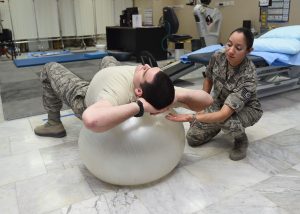Rehabilitation strategy drives improvement in CRPS

Complex regional pain syndrome is a debilitating condition. This study demonstrates that both physical therapy and occupational therapy are beneficial in treating complex regional pain syndrome. Physical therapy, also known as physiotherapy, is a physical medicine and rehabilitation specialty that, by using mechanical force and movements, remediates impairments and promotes mobility, function, and quality of life through examination, diagnosis, prognosis, and physical intervention. It is performed by physical therapists. While physical therapy aims to increase mobility and function, occupational therapy is focused on helping people live as independently as possible. There is some overlap between the two; several methods of physical therapy are used as part of occupational therapy.
The Research
The Place of Occupational Therapy in Rehabilitation Strategies of Complex Regional Pain Syndrome: Comparative Study of 60 Cases
Hand Surg Rehabil. 2016 Oct;35(5):355-362. doi: 10.1016/j.hansur.2016.06.005. Epub 2016 Sep 23.
Rome L1.
- 1Service de médecine physique et de réadaptation, site Paul-Ribeyre, pavillon 5, centre hospitalier d’Ardèche Méridionale, avenue Paul-Ribeyre, 07600 Vals-les-bains, France. Electronic address: Chtlucie2@aol.fr.
Abstract
The purpose of the study was to assess the value of combining occupational therapy (OT) with physical therapy (PT) for the rehabilitation of complex regional pain syndrome (CRPS) and to measure its effectiveness on activities of daily life. Sixty patients with CRPS type 1 were recruited and interviewed between September 1, 2014 and February 1, 2015. Thirty patients had undergone PT and thirty had undergone PT+OT. They were administered the short-form of the “Assessment of Life Habits” questionnaire (v.3.0 LIFE-H) created in Canada. This questionnaire consists of 16 items exploring activities of daily living, which were used to compare the effectiveness of the two rehabilitation protocols. The results of each test were submitted to the Wilcoxon test. After confirming the complexity of CRPS in terms of its etiology, clinical signs and progression, rehabilitation was effective, especially for pain. The patients who received PT+OT had on average 10% better dressing and undressing function, 25% better for meal preparation, and 20% better on personal care than those who underwent PT only. In CRPS, OT combined with PT brings a real benefit in restoring the essential activities of daily life. This strategy could be implemented as soon the diagnosis confirmed and continued for a very long time. It helps to avoid the risk of dependence on third parties.
Copyright © 2016 SFCM. Published by Elsevier Masson SAS. All rights reserved.
Keywords
Activities of daily living; Activités de la vie quotidienne; Assessment of Life Habits; Complex regional pain syndrome; Ergothérapie; Functional rehabilitation; Mesure des habitudes de vie; Occupational therapy; Rééducation fonctionnelle; Syndrome douloureux régional complexe











